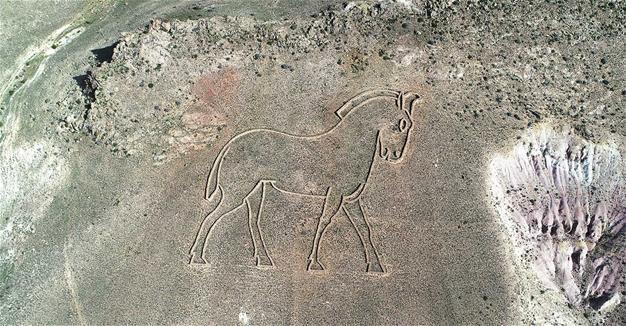Cappadocia’s sculptures seek attention
AKSARAY

Australian sculptor Andrew Rogers’ sculptures created as part of his land art project “Rhythms of Life” seek interest, as their location is difficult to reach for tourists.
“Rhythms of Life” embodies the changing rhythms of life reflected in the juxtaposition of shape and line echoing life’s unpredictable journey. The sculptures are located in Turkey’s Cappadocia region and were created between 2007 and 2009.
The project, encompassing 13 countries, demonstrates how art and nature can enhance each other. The sculptures reflect traces from human life and have different themes. The largest of Rogers’ stone structures is “A Day on Earth,” found in the “Time and Space” land art park in Cappadocia, which is a spectacular Fibonacci sequence of 12 basalt pillars. Among the other sculptures is the geoglyph “The Gift,” derived from a 6,000 year-old rock carving signifying the important role horses played in Cappadocia in ancient times while “Grind” is derived from millstone that belonged to the elders of the town of Göreme in Cappadocia.
There is also an arch and carved amphitheater titled “Listen” and “Predicting the Past” is about the difference between the past and the future.
“Sentinels” is the responsibility for generations to come and “Siren” depicts human head and body of a bird – in shamanistic beliefs they accompany humans in their journeys to the underworld and the heavens.
The others are “Strength,” a double-bodied lion derived from an image found in the Sultanhanı Township in Aksaray, “Sustenance,” featuring a date palm motif that is found on a royal tomb built in the 13th century on the Kayseri Talas road and “Yesterday Today Tomorrow,” a triangular formation surrounded by a circle of stone; and “Presence” which comprises 24 basalt columns.
Rogers worked in various parts of Karadağ in the Central Anatolian province of Nevşehir’s Göreme to feature the natural and historic beauties of the region that can be seen from Google Earth. Due to the limited transportation options, tourists rarely visit the sculptures. The case of the construction of a road making transportation easier to Karadağ would allow the region to host more people.
A Nevşehir local, photographer İlker Katık, who spoke to Anadolu Agency, said Cappadocia, which is a wonder of the world, hosts tourists from all around the world.
He said the sculptures made by Rogers in Karadağ are important for Cappadocia tourism. “The sculptures may add value to Cappadocia tourism but because of suspicious approaches and indifference, they do not receive the interest they deserve. These sculptures should be promoted and a road to the sculptures should be constructed. Since they are made of natural stone, the sculptures can easily become integrated with Cappadocia.”
About the projectRogers’ land art is a mega-scale project, with 51 sculptures spanning across 16 countries in all seven continents. It has involved more than 7,500 people over 16 years.
For Rogers, the motivation to create these pieces of art, which is a series of stone sculptures or geoglyphs that have taken form across mountains, valleys and plains around the world, started from an idea to denote separation from the ordinary and provide contemplative settings.
A particular purpose is to establish consecrated space, provide an impetus to show linkages between structures and environment, and to allow for contemplative narrative around the search for heritage.
Rogers works to use only local materials readily available to construct each sculpture, ensuring local flora is undisturbed. Each creation is conceived of with the assistance of local communities including elders, local workers and experts.
 Australian sculptor Andrew Rogers’ sculptures created as part of his land art project “Rhythms of Life” seek interest, as their location is difficult to reach for tourists.
Australian sculptor Andrew Rogers’ sculptures created as part of his land art project “Rhythms of Life” seek interest, as their location is difficult to reach for tourists.